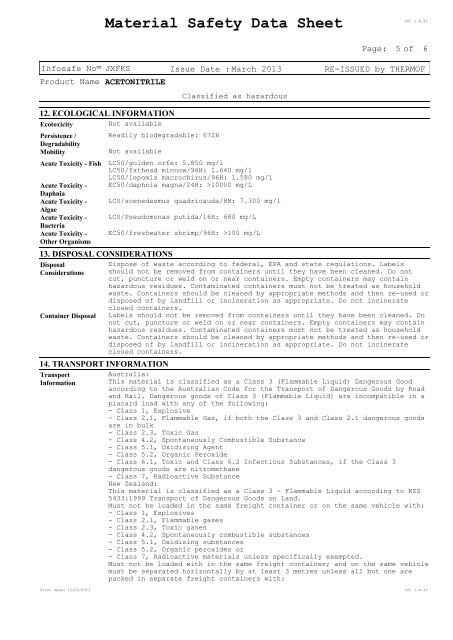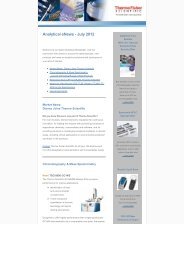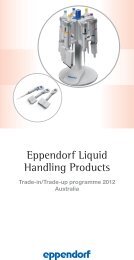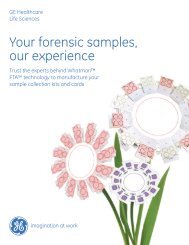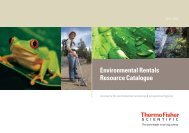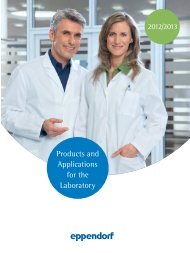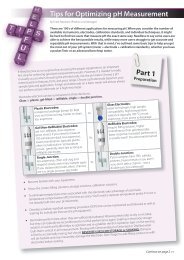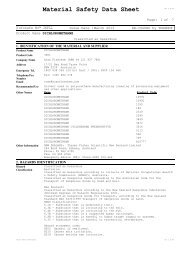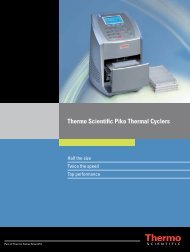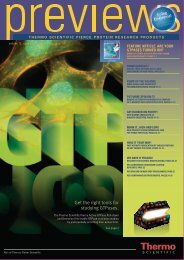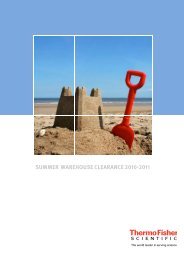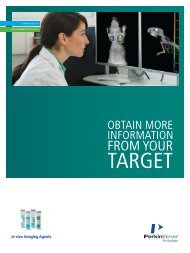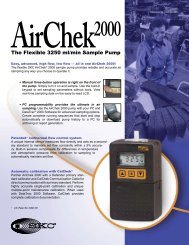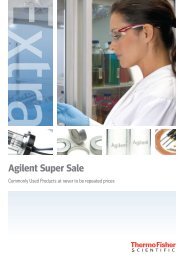View MSDS - Thermo Fisher
View MSDS - Thermo Fisher
View MSDS - Thermo Fisher
Create successful ePaper yourself
Turn your PDF publications into a flip-book with our unique Google optimized e-Paper software.
Material Safety Data Sheet<br />
CS: 1.4.93<br />
Page: 5 of<br />
6<br />
Infosafe No JXFKS Issue Date : March 2013 RE-ISSUED by THERMOF<br />
Product Name ACETONITRILE<br />
12. ECOLOGICAL INFORMATION<br />
Ecotoxicity<br />
Persistence /<br />
Degradability<br />
Mobility<br />
Acute Toxicity - Fish<br />
Acute Toxicity -<br />
Daphnia<br />
Acute Toxicity -<br />
Algae<br />
Acute Toxicity -<br />
Bacteria<br />
Acute Toxicity -<br />
Other Organisms<br />
Not available<br />
Readily biodegradable: 672H<br />
Not available<br />
Classified as hazardous<br />
LC50/golden orfe: 5.850 mg/l<br />
LC50/fathead minnow/96H: 1.640 mg/l<br />
LC50/lepomis macrochirus/96H: 1.580 mg/l<br />
EC50/daphnia magna/24H: >10000 mg/L<br />
13. DISPOSAL CONSIDERATIONS<br />
Disposal<br />
Considerations<br />
Container Disposal<br />
14. TRANSPORT INFORMATION<br />
Transport<br />
Information<br />
LC0/scenedesmus quadricauda/8H: 7.300 mg/l<br />
LC0/Pseudomonas putida/16H: 680 mg/L<br />
EC50/freshwater shrimp/96H: >100 mg/L<br />
Dispose of waste according to federal, EPA and state regulations. Labels<br />
should not be removed from containers until they have been cleaned. Do not<br />
cut, puncture or weld on or near containers. Empty containers may contain<br />
hazardous residues. Contaminated containers must not be treated as household<br />
waste. Containers should be cleaned by appropriate methods and then re-used or<br />
disposed of by landfill or incineration as appropriate. Do not incinerate<br />
closed containers.<br />
Labels should not be removed from containers until they have been cleaned. Do<br />
not cut, puncture or weld on or near containers. Empty containers may contain<br />
hazardous residues. Contaminated containers must not be treated as household<br />
waste. Containers should be cleaned by appropriate methods and then re-used or<br />
disposed of by landfill or incineration as appropriate. Do not incinerate<br />
closed containers.<br />
Australia:<br />
This material is classified as a Class 3 (Flammable Liquid) Dangerous Good<br />
according to the Australian Code for the Transport of Dangerous Goods by Road<br />
and Rail. Dangerous goods of Class 3 (Flammable Liquid) are incompatible in a<br />
placard load with any of the following:<br />
- Class 1, Explosive<br />
- Class 2.1, Flammable Gas, if both the Class 3 and Class 2.1 dangerous goods<br />
are in bulk<br />
- Class 2.3, Toxic Gas<br />
- Class 4.2, Spontaneously Combustible Substance<br />
- Class 5.1, Oxidising Agent<br />
- Class 5.2, Organic Peroxide<br />
- Class 6.1, Toxic and Class 6.2 Infectious Substances, if the Class 3<br />
dangerous goods are nitromethane<br />
- Class 7, Radioactive Substance<br />
New Zealand:<br />
This material is classified as a Class 3 - Flammable Liquid according to NZS<br />
5433:1999 Transport of Dangerous Goods on Land.<br />
Must not be loaded in the same freight container or on the same vehicle with:<br />
- Class 1, Explosives<br />
- Class 2.1, Flammable gases<br />
- Class 2.3, Toxic gases<br />
- Class 4.2, Spontaneously combustible substances<br />
- Class 5.1, Oxidising substances<br />
- Class 5.2, Organic peroxides or<br />
- Class 7, Radioactive materials unless specifically exempted.<br />
Must not be loaded with in the same freight container; and on the same vehicle<br />
must be separated horizontally by at least 3 metres unless all but one are<br />
packed in separate freight containers with:<br />
Print Date: 12/03/2013 CS: 1.4.93


